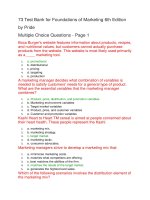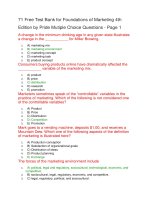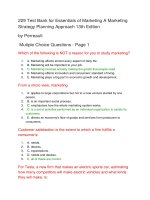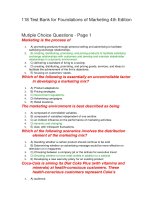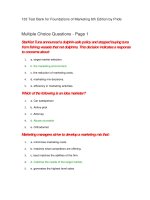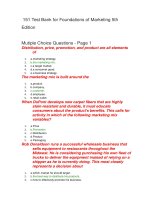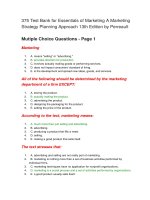Test bank for foundations of maternal newborn and womens health nursing 5th edition by murray
Bạn đang xem bản rút gọn của tài liệu. Xem và tải ngay bản đầy đủ của tài liệu tại đây (48.07 KB, 5 trang )
buy this full document at
Murray: Foundations of Maternal-Newborn and Women's Health Nursing,
5th Edition
Chapter 01: Maternity and Women's Health Care Today
Test Bank
MULTIPLE CHOICE
1. Which statement is true about the characteristics of a healthy family?
a. The parents and children have rigid assignments for all the family tasks.
b. Young families assume total responsibility for the parenting tasks, refusing any
assistance.
c. The family is overwhelmed by the significant changes that occur as a result of
childbirth.
d. Adults agree on the majority of basic parenting principles.
ANS: D
Adults in a healthy family communicate with each other, so there is minimal discord in areas
such as discipline and sleep schedules.
Healthy families remain flexible in their role assignments.
Members of a healthy family accept assistance without feeling guilty.
Healthy families can tolerate irregular sleep and meal schedules, which are common during
the months after childbirth.
DIF: Cognitive Level: Application
OBJ: Nursing Process Step: Assessment
MSC: Client Needs: Health Promotion and Maintenance
REF: 13
2. Which factor significantly contributed to the shift from home births to hospital births in
the early twentieth century?
a. Puerperal sepsis was identified as a risk factor in labor and delivery.
b. Forceps were developed to facilitate difficult births.
c. The importance of early parent-infant contact was identified.
d. The number of hospital births decreased.
ANS: B
The development of forceps to facilitate difficult births by physicians was a strong factor in
the decrease of home births and increase of hospital births.
Puerperal sepsis has been a known problem for generations. In the late nineteenth century,
Semmelweis discovered how it could be prevented.
The shift to hospital births decreased the parental-infant contact.
With the shift towards hospital births, the numbers increased.
DIF: Cognitive Level: Knowledge
OBJ: Nursing Process Step: Assessment
MSC: Client Needs: Safe and Effective Care Environment REF: 2
buy this full document at
Full file at />3.
a.
b.
c.
Family-centered maternity care developed in response to:
Demands by physicians for family involvement in childbirth.
The Sheppard-Towner Act of 1921.
Parental requests that infants be allowed to remain with them rather than in a
nursery.
d. Changes in pharmacologic management of labor.
ANS: C
As research began to identify the benefits of early extended parent-infant contact, parents
began to insist that the infant remain with them. This gradually developed into the practice of
rooming-in and finally to family-centered maternity care.
Family-centered care was a request by parents, not physicians.
The Sheppard-Towner Act provided funds for state-managed programs for mothers and
children.
The changes in pharmacologic management of labor were not a factor in family-centered
maternity care.
DIF: Cognitive Level: Comprehension OBJ: Nursing Process Step: Assessment
MSC: Client Needs: Health Promotion and Maintenance
REF: 3
4. African Americans whose incomes fall below the poverty level have the highest infant
mortality rate in the United States because:
a. Infectious diseases are more prevalent.
b. More African American infants are born with congenital anomalies.
c. Their diets are deficient in protein.
d. Inadequate prenatal care is associated with low-birth-weight infants.
ANS: D
Inadequate prenatal care is the major factor associated with low-birth-weight infants, who are
less likely to survive.
Infectious disease is not more prevalent in the African American population.
There is not a higher incidence of congenital anomalies in the African American population.
A deficiency in protein is not a risk factor associated with infant mortality.
DIF: Cognitive Level: Comprehension OBJ: Nursing Process: Assessment
MSC: Client Needs: Health Promotion and Maintenance
REF: 17
5.
a.
b.
c.
d.
Which situation is most representative of an extended family?
It contains children from previous marriages.
It is composed of children, parents, and grandparents living in the same house.
It is headed by a single parent.
It includes adoptive children.
ANS: B
An extended family is defined as one having members from three generations living under
the same roof.
Elsevier items and derived items © 2010, 2006, 2002, 1998, 1994 by Saunders, and imprint of Elsevier Inc.
Full file at />A blended family is one that contains children from previous marriages.
A single-parent family is headed by a single parent.
A family with adoptive children is a nuclear family.
DIF: Cognitive Level: Comprehension OBJ: Nursing Process: Assessment
MSC: Client Needs: Health Promotion and Maintenance
REF: 13
6.
a.
b.
c.
d.
Which setting for childbirth allows for the least amount of parent-infant contact?
Labor/delivery/recovery room
Birth center
Traditional hospital birth
Home birth
ANS: C
In the traditional hospital setting, the mother may see the infant for only short feeding
periods, and the infant is cared for in a separate nursery.
The labor/delivery/recovery/postpartum room setting allows increased parent-infant contact.
Birth centers are set up to allow an increase in parent-infant contact.
Home births allow an increase in parent-infant contact.
DIF: Cognitive Level: Knowledge
OBJ: Nursing Process Step: Planning
MSC: Client Needs: Health Promotion and Maintenance
REF: 4
7. A woman giving birth in the 1960s may have been given a narcotic plus scopolamine for
pain control. One major problem with this medication regimen was:
a. Its lack of continuous pain control.
b. It was expensive and available only to women who could afford the medications.
c. It caused confusion and disorientation so the mother could not see the infant for
several hours postdelivery.
d. The father had to assume the role of decision maker during the time the mother
was on medication.
ANS: C
The combination of narcotics and scopolamine produced heavy sedation and disorientation.
The new mother was not fully awake and oriented for several hours postdelivery. The
bonding process had to be delayed.
The narcotic plus scopolamine did allow for continuous pain control.
The combination was not expensive and would be given to any mother.
The father was almost always the decision maker during the 1960s.
DIF: Cognitive Level: Knowledge
OBJ: Nursing Process: Assessment
MSC: Clients Needs: Physiological Integrity REF: 2
8. One advantage to labor, delivery, recovery, and postpartum rooms is:
a. The woman's support system is encouraged to stay until discharge.
b. They are less expensive than traditional hospitals.
Elsevier items and derived items © 2010, 2006, 2002, 1998, 1994 by Saunders, and imprint of Elsevier Inc.
Full file at />c. The infant is removed to the nursery to allow the mother to rest.
d. The family is in a familiar environment.
ANS: A
Sleeping equipment is provided and the support system is encouraged to stay.
An LDRP is not less expensive then a traditional hospital room.
The concept is to have the baby with the mother at all times.
A hospital setting is never a familiar environment.
DIF: Cognitive Level: Knowledge
OBJ: Nursing Process: Assessment
MSC: Client Needs: Health Promotion and Maintenance
REF: 4
MULTIPLE RESPONSE
1. Many communities now offer the availability of free-standing birth centers to provide
care for low-risk women during pregnancy, birth, and postpartum. When counseling the
newly pregnant woman regarding this option, the nurse should be aware that this type of
care setting includes which advantages? Select all that apply.
a. Less expensive than acute-care hospitals
b. Access to follow-up care for 6 weeks postpartum
c. Equipped for obstetric emergencies
d. Safe, home-like births in a familiar setting
e. Staffing by lay midwives
ANS: A, B, D
Correct: A, B, D. Women who are at low risk and desire a safe, home-like birth are very
satisfied with this type of care setting. The new mother may return to the birth center for
postpartum follow-up care, breastfeeding assistance, and family planning information for 6
weeks postpartum. Since birth centers do not incorporate advanced technologies into their
services, costs are significantly less than a hospital setting.
Incorrect: C, E. The major disadvantage of this care setting is that these facilities are not
equipped to handle obstetric emergencies. Should unforeseen difficulties occur, the woman
must be transported by ambulance to the nearest hospital. Birth centers are usually staffed by
certified nurse-midwives (CNMs); however, in some states lay midwives may provide this
service.
DIF: Cognitive Level: Comprehension OBJ: Nursing Process Step: Planning
MSC: Client Needs: Safe and Effective Care Environment REF: 4
COMPLETION
Elsevier items and derived items © 2010, 2006, 2002, 1998, 1994 by Saunders, and imprint of Elsevier Inc.
Full file at />1. Interventions, modalities, professions, theories, applications, or practices that are not
currently part of the conventional medical system in North American culture are often
referred to as ____________________ or ____________________ medicine.
ANS:
complementary; alternative
alternative; complementary
For many people such therapies are not considered alternative, because they are mainstream
in their culture. Others combine them with traditional medical practices, thereby using an
integrative approach. A continued concern is client safety. Some clients who use these
techniques may delay necessary care, and others may take herbal or other remedies that
might become toxic when used in combination with prescription drugs or taken in excess.
DIF: Cognitive Level: Comprehension OBJ: Nursing Process Step: Assessment
MSC: Client Needs: Physiologic Integrity
REF: 11
Elsevier items and derived items © 2010, 2006, 2002, 1998, 1994 by Saunders, and imprint of Elsevier Inc.

